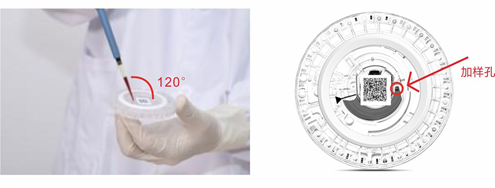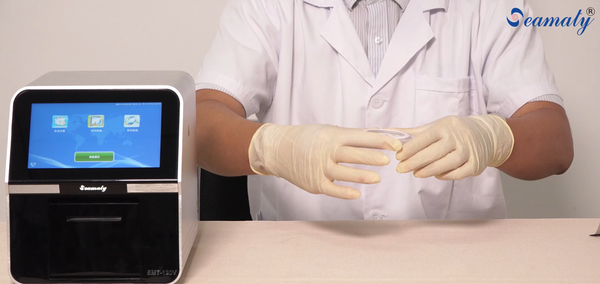release time:2021-04-21 10:22:05
Although the operation of the veterinary biochemical analyzer SMT-120V is simple, there are some precautions you need to know. The correct use of the biochemical analyzer can avoid abnormal results and provide correct data for clinical judgment.
I will share some matters needing attention for using SMT-120V.

Please do not use a purple EDTA anticoagulation tube when using SMT-120V test items, because EDTA is an inhibitor of many enzymes, and it can chelate metal ions such as calcium and magnesium, but these metal ions are often activators of many enzymes. The use of an EDTA anticoagulation tube may lead to abnormal test results of some items, such as calcium and amylase.
1. You can only use the first gear of the pipette when sampling and adding samples. Otherwise, the sample will enter the working channel inside the reagent tray in advance, resulting in an abnormal test report.

2. When adding samples, tilt the pipette gun to the direction of sample flow at about 120° and slowly inject the sample. After adding the sample, lift the pipette gun and then release your finger to prevent the sample from sucking backward, resulting in the insufficient sample volume. If this happens, the sample can be added to the reagent tray again, but it must be noted that the sample cannot enter the working channel of the reagent tray in advance.

1. Reagent disc returned to room temperature: After taking it out of the refrigerator at 2-8°C, let it return to temperature for 20 minutes. It is forbidden to open the aluminum foil packaging bag in advance to prevent the effect of reagent beads from becoming invalid.
2. The way to hold the reagent disc: You should clamp the side of the reagent disc so that the front side with the QR code is facing up. When removing the reagent disc, please hold the edge of the reagent tray, and do not touch the surface of the reagent disc and the QR code. After unpacking the reagent disc, it should be used within 10 minutes.

Plasma is the upper clear liquid after centrifugation in the anticoagulation tube.
(Attention: When sampling whole blood samples after being placed for a period of time, try to take the upper part of the blood collection tube to avoid collecting too many blood cells, which may cause abnormal results)

Samples with severe hemolysis, lipemia, jaundice, viscous or dehydration, etc., need to be centrifuged or tested with plasma filtered by a special filter to avoid error reporting
(Note: Severe hemolysis, lipemia, and jaundice will affect some test values, the results are for reference only)
If you can't remember, you can right-click to save this small operation prompt and view it at any time.


2021-04-22
The blood coagulation reagent with four indexes launched by Chengdu Seamaty Technology Co., Ltd. used with SMT-120V, an automatic biochemical analyzer, is suitable for preoperative examination of pets, which can help doctors to understand whether the animal's hemostatic function is defective. The preoperative examination can prevent intraoperative bleeding.

2021-04-20
The ammonia produced by the catabolism of various amino acids in various tissues in the body and the ammonia absorbed from the intestinal tube enter the blood to form blood ammonia. Precautions for detecting blood ammonia

2021-04-20
The most common blood tests in pet hospitals are biochemical tests and routine blood tests. Veterinary biochemical instrument is an instrument for biochemical examination of animals. Before routine physical examination and sterilization surgery, pet doctors will recommend biochemical examination.